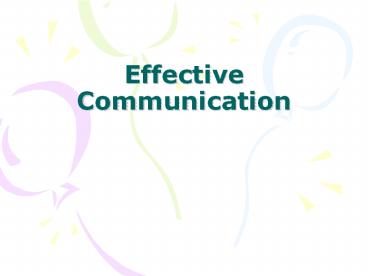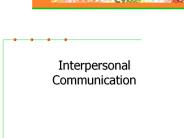Effective Communication - PowerPoint PPT Presentation
1 / 40
Title: Effective Communication
1
Effective Communication
2
What is Communication?
3
Communication
- The sharing of a thought, an idea or a feeling.
4
(Feedback)
5
- Communication involves a purposeful generation
and transmission of a message - Involves a sender, message and receiver
- Reading, writing, listening, touching and seeing
are all apart of the communication process.
6
(No Transcript)
7
Elements of Effective Communication
8
Message must be clear
9
- Use words the patient and family can understand.
- Ex Dont say I need to listen to your apical
pulse say I need to listen to your heart
beat.
10
Clear and Concise
11
- Correct pronunciation and good grammar are
essential. - Avoid slang words and phrases like you know,
um, and all that stuff
12
(No Transcript)
13
Hearing is important
14
- Find other ways to get the message to the
patient. - Hard of hearing, limited English, heavily
medicated.
15
(No Transcript)
16
Must be able to understand
- If it looks like the patient doesnt understand,
ask questions or restate information. - Patient may have language barrier or speech
impediment - Receivers attitude and prejudices may interfere
with understanding. - HCW must be aware of their own prejudices and
attitudes when receiving messages.
17
(No Transcript)
18
Minimize disruptions
19
- Interruptions or distractions can interfere with
communication - Caused by loud noises, uncomfortable temp, bright
light, phones, loud television, radio
20
(No Transcript)
21
Listening
22
- Essential part of effective communication
- Involves paying attention and making an attempt
to hear what is being said. - Must develop good listening skills
23
How to be a good listener
- Show interest and concern
- Be alert and
- maintain eye contact
- Avoid interrupting the speaker
24
- Avoid thinking about how you will respond
- Eliminate distractions
- Ask for clarification
25
- Keep your temper under
- control and maintain
- a positive attitude.
- Eliminate your prejudices
- and try to see the
- other persons
- point of view
26
- Why do we communicate?
27
- Build relationships
- Give instructions
- Gather information
- Reports
28
Describe this
29
What about this?
30
Types of Communication
- Verbal
- Non-verbal
31
Nonverbal Communication
- Nonverbal messages carry more meaning than verbal
messages - Involves facial expressions, body language,
gestures, eye contact and touch
32
(No Transcript)
33
- Must be aware of own body language and the
message it may convey - Must be aware of patients body language as well.
- When verbal and nonverbal messages agree,
receiver is more likely to understand
34
Cultural Diversity
35
Culture
- Values, beliefs, attitudes, and customs shared by
a group of people
36
- Culture may be a barrier to communication in
healthcare setting - Beliefs about what causes illness and how to
treat it.
37
- Language differences-find an interpreter
- Eye contact-looking down vs. eye-to-eye contact
- Patient may not make healthcare decisions
38
- Touch-may be inappropriate to touch on the head
- Only family
- members provide
- personal care
39
- Respect for and acceptance of cultural diversity
is essential for any health care worker.
40
Summary
- Write down 3 things you have learned about
communication. - How will you use what you have learned when
communicating?































